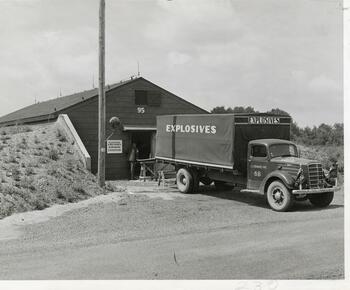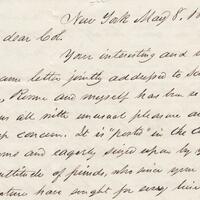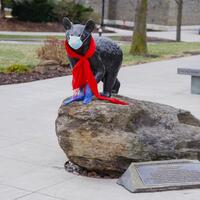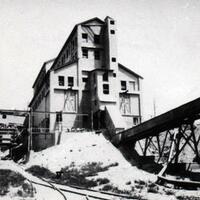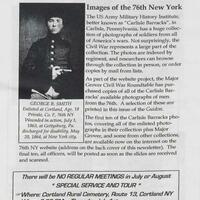On December 11, 1941, Germany declared war on the United States. Three months later, 250 families living between the Oswego and Seneca Rivers, on and round the Radisson site, were ordered by the Army Corps of Engineers to evacuate their homes. Eight thousand acres of land were depopulated by the orders, and all roads into the area were blocked. Within a month, construction of a huge ordnance plant began, with more than 3,000 workers employed at the peak of construction. By January 1943, less than a year later, the plant was in operation. The plant was under heavy security. Ten miles of chain link fencing with strategically located guard towers protected it. At night, floodlights played on all perimeter areas. Inside were 88 main buildings and more than 20 miles of roads. Eight thousand men and women worked there. They made, processed and shipped dinitrochlorabenzene, more familiarly known as “Explosive D.” It was used in armor piercing shells, and it and its processing were deadly business.
“Explosive D” was made, basically, from a peaceful enough coal tar derivative used for dye making. But, by the time the Works got through treating it with nitric and sulphuric acids, boiling it and cooling it and, finally, shipping it, it was anything but peaceful. It was stored in concrete magazines located generally in the area of what is now the Game Management Preserve, along Sixty Road.
The most dangerous operations were conducted in buildings along the east side of Radisson’s drumlin. This was done so that, in the event of an explosion, Baldwinsville would be shielded from danger. The concrete foundations along the east side of the drumlin, off Willett Parkway, were part of that main manufacturing area. They supported acid vats used in processing the explosive. The architectural sculpture that identifies Radisson’s main entrance at Route 31 was conceived in 1974 by Sergi Yevich of Baldwinsville who was an architect and planner for Radisson. He used the shape of the cradles that supported those vats as the basis for his design. The actual cradles were half the size of those in the finished sculpture. There were five of these areas along the face of the drumlin.
A year and two months after production began, it was stopped. Following the War, the property was declared surplus, and the Works were abandoned. The next few years, as the Works were dismantled or destroyed and the property disposed of, were active ones. Only the administration buildings near Rt. 31 and some of the larger concrete buildings remained.
Some farmhouses and cottages left from before the War were offered to the public for lease. A plan to use the larger buildings for veteran’ housing fell through. Over 5600 acres went into the land bank and was eventually sold. State officials looked into the possibility of relocating the State Fair there but then decided not to. Syracuse University began renovating some of the buildings for student housing, but the work was never completed.
The State Conservation Department purchased 3000 acres in the north end of the property from the Game Management Preserve. Later, in 1952, the trustees of the William Waldorf Astor estate bought 2000 acres for residential and commercial development. This never took place. For the next 20 years, the land stood idle.
In 1969, the Urban Development Corporation (UDC) purchased the site and in 1971 they began developing a Planned New Community. It is now called Radisson, The name being derived from a mid-17th Century French explorer of the Syracuse area, Pierre Esprit Radisson, who was also a co-founder of the Hudson Bay Company.
